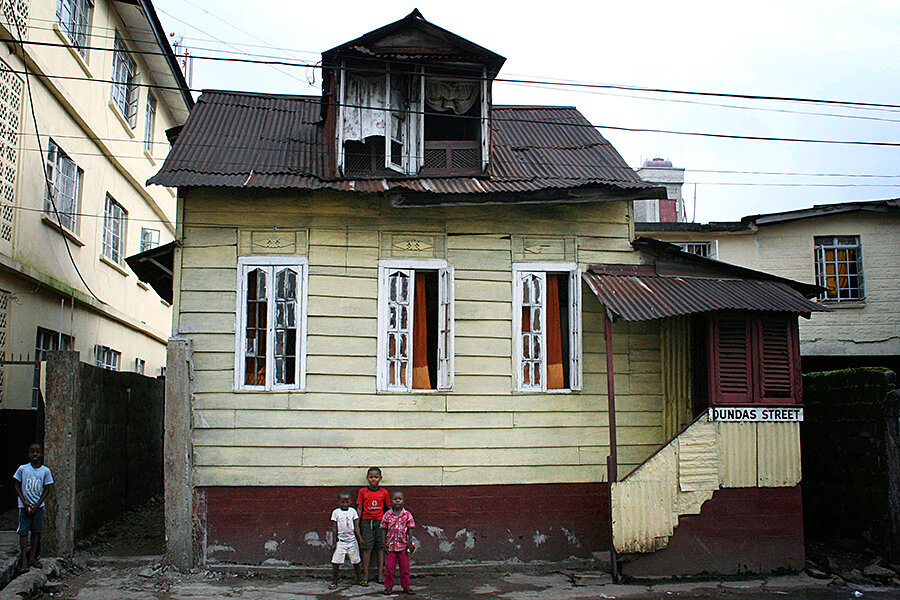Once influential, slave descendants in Sierra Leone face a less certain future
Loading...
| Regent, Sierra Leone
With its covered porch and colorfully shuttered windows, the board house Melissa Smart owns in the steep green hills near Freetown looks like it may have been transported here by time machine — from colonial South Carolina, perhaps, or maybe 19th-century New Orleans.
Actually, that is not far off the mark. The house is more than 150 years old, and it was built by Ms. Smart’s great-great grandparents, descendants of a group of freed American slaves who settled here in the late 18th century.
“I’m proud to live in a house like this because when you come into this village and you see this place, straight away you know it’s Krios living here,” she says, referring to the Sierra Leonean ethnic group descended from these freed slaves. “My great-grandmother was born here in this house, and every generation since has been too.”
Like their better-known Americo-Liberian neighbors, Krios scramble the commonly known history of West Africa’s role in the transatlantic slave trade—providing a tale of people crossing the Atlantic not into slavery, but out of it; sailing not away from Africa, but back toward it.
But while that legacy has left a cosmopolitan imprint on Sierra Leonean society, it’s also saddled Krios with a sometimes difficult relationship with the country around them, leaving them at times poised between a dramatic past and uncertain future.
“For much of the colonial era, Freetown was seen as the ‘Athens of West Africa’ — a center of education and culture — and Krios were a great force in many disciplines and in political life,” says Sylvanus Spencer, a Krio scholar who is head of the department of history and African Studies at Fourah Bay College in Freetown, West Africa’s oldest university. “But we were considered [by many] the ‘black white men,’ and that’s been a complicated legacy.”
The historical legacy of Krios in Freetown is a highly visible one, from the intricately wrought iron balconies and colorful dormers that characterize its architecture to the language spoken on its streets, an English-based Creole spattered with vocabulary from West African tongues, Portuguese, and Jamaican Patois. More than 90 percent of Sierra Leoneans understand the language, despite the fact that Krios make up only about 4 percent of the population.
“I think the Krio language is our greatest contribution here — it is what binds us together as Sierra Leoneans,” says Charlie Haffner, a celebrated KRIO playwright and actor and member of Sierra Leone’s Monuments and Relics Commission. “When you hear someone speak Krio, you don’t know what tribe he is. That’s a beautiful thing.”
A cosmopolitan Freetown
The people who became Krios arrived here in waves in the late 18th and early 19th centuries, spurred by abolitionist demands that former slaves be returned to their “rightful” homes in Africa. Some were so-called black loyalists, slaves who “earned” their freedom from the British for fighting against the Americans in the Revolutionary War. Others were Jamaican maroons — communities of escaped slaves — while still others had been rescued from illegal slave ships attempting to sneak their cargo to American markets after the formal abolition of the slave trade in the British Empire in 1807.
Those early settlers were incredibly culturally diverse, says Joseph Opala, a retired professor of history at James Madison University who has spent much of his career studying the links between Sierra Leoneans and black Americans.
“In the 1840s, a German linguist named Sigismund Kroelle came to Freetown to study African languages, because he said it was the only place on the continent where you could find people speaking hundreds of different languages in one spot,” he says. “It was really like nothing else in the world.”
Those distinctive communities slowly fused, he says, drawn together in part by their shared Western influence. Today Krios are easily identified by their seemingly European last names (Williams, Johnson, Smith, Cole) and hometowns that sound like they were plucked directly from an atlas of the British Isles (Leicester, Waterloo, Gloucester, Sussex). Until a few decades ago, their most identifiable “cultural dress” consisted of top hats and frock coats for men, ornate Victorian dresses for women.
Changing tides
But that history may also provide an important clue to their dwindling influence here. Once prized by colonial administrators for their Western sensibilities and elevated to many important posts in the British Administration of Sierra Leone, Krios have historically straddled different worlds. Many now have extensive ties in the diaspora, and when crisis strikes in Sierra Leone — be it the civil war that raged here between 1991 and 2002, or more recently the Ebola crisis — they are frequently the first to flee.
During the war, Spencer says, the wooden Krio houses around Freetown were an easy target for advancing rebels, and hundreds were reduced to ash. Many of the Krio board houses that survived in Krio villages like Smart’s were torn down or are now rented by other Sierra Leoneans, their landlords having gone abroad to the United Kingdom or United States.
“For me, this isn’t a problem really — culture isn’t static, it changes,” says Mr. Spencer. “Trying to get it to stay the same will always be an uphill battle.”
It’s a feeling that Smart, the board-house owner, shares. Throughout her village, she says, she has watched over the years as old Krio houses like hers have been bulldozed to make way for newer, fancier buildings.
“People want to live in concrete houses now,” she says. “Because they have money, they want something new. I don’t think it’s a problem. The environment is changing.”









